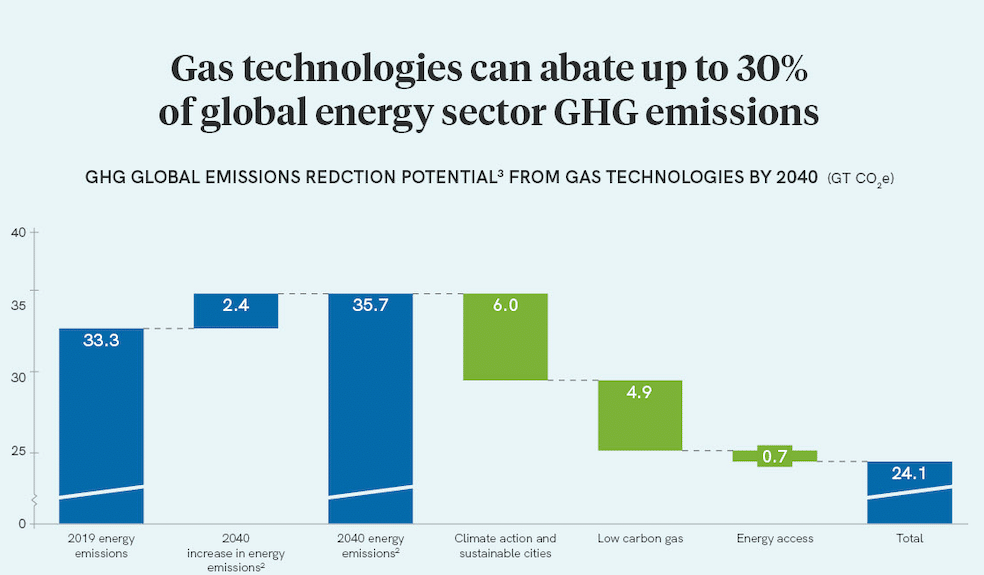Meeting the energy needs of the world’s expanding population sustainably, while fuelling economic growth and prosperity is one of the greatest challenges of our time.
The energy transition needs to deliver an affordable, resilient, secure and sustainable energy system, reducing greenhouse gas (GHG) and air pollutant emissions. In this process, it also needs to expand access to clean and modern energy to those who do not have it. This challenge can only be met with a well-rounded combination of policy measures and sustained investment in cleantech. Renewable energy and natural gas are critical pieces of that combination.
Gas is particularly well placed to support this transition as the least carbon intensive hydrocarbon, which offers high efficiency, flexibility of use, availability on demand, and secure access. In fact, technologies and innovation in the gas sector could have a transformative impact on global energy systems. There is a vast array of gas technologies, ranging from highly mature to nascent, whose deployment has the potential to economically reduce one third of emissions from the energy sector by 2040.
Together, the Paris Agreement and the 2030 Agenda are the world’s most ambitious commitments to solving this century’s biggest double challenge: fair development and climate change. Today, the world is not on track to solve it. Gas technologies can play a decisive role in support of the two agreements, by enabling action on climate change, by promoting sustainable cities and communities, and by providing access to clean and affordable energy.
Meeting the Paris Agreement
To address emission reductions affordably and effectively, early action is required on all fronts. This is especially true in the natural gas sector, the clear choice to provide an affordable lower carbon replacement to coal and oil at sufficient scale within the timescale required. Increasing access to gas in areas of growing demand can provide immediate reductions in GHGs, particulates, sulphur and nitrous oxide emissions. This would have a great cumulative impact over the next 30 years in terms of reduced carbon emissions and a healthier living environment, and all at a lower cost than the alternatives.
Most importantly, this would be an economic investment, in a sustainable growth scenario where emissions are priced in accordance to their social and environmental cost.

Gas technologies report
A recent report , completed jointly by the International Gas Union and the Boston Consulting Group, presented a comprehensive review of gas technologies in 12 different categories, across mid-, downstream, end-use, and low-carbon gas markets. It found that economically and environmentally sound deployment of natural gas technologies would remove 30% of GHG emissions from the energy sector and a fifth of total global emissions by 2040.This represents a substantial contribution to the emissions gap which must be closed to achieve the goals of the Paris Agreement on Climate Change.
According to the UN, by 2030, emissions would need to be 25%-55 % lower than in 2018 to put the world on the least-cost pathway to limiting global warming to below 2˚C and 1.5°C respectively. Gas technologies provide a quick and economical ramp to that pathway. It is true that gas cannot address this emissions gap in its entirety, and other cleantech solutions are also essential, but the potential for progress is too large to ignore, especially given the relative ease of implementation. But this will not happen on its own. The industry and governments must support gas technology and innovation and gas infrastructure investments in their post-pandemic recovery strategies.
Emissions reductions and Clean Air
A Combined Cycle Gas Turbine (CCGT) plant emits about 400 kg/MWh gross of CO2, less than half that of the 900 kg/MWh emitted by a super critical coal plant. Particulates and nitrogen oxides emissions are very low from a CCGT and sulphur dioxide emissions practically non-existent, as natural gas does not contain sulphur. Fuel switching in the power sector represents the single largest opportunity for the sustainable deployment of gas technology – namely, using gas to its full economic potential in the power sector would save 3.3 gigatons (Gt) of CO2 by 2040.
Other sectors also offer significant fuel switching opportunities, which would have a large impact on emissions levels.
In industry, where recent innovations in gas technology have delivered higher efficiencies and lower costs, a further 2 Gt of CO2 by 2040 could be abated. Replacing coal and oil products used in buildings would eliminate a further 0.5 Gt, while an additional 0.5 Gt reduction could be achieved in transport, mainly in the heavy-duty road and maritime sectors. In industry, natural gas is the most efficient energy source for process heat generation and the least emitting feedstock for petrochemicals other than biofuel inputs. Efficient electrification technologies for industrial applications can cost up to five times more than gas on a levelized basis.
In total, if gas replaces oil and coal to its economic potential, 6.3 Gt of CO2 would be abated by 2040. However, in many areas of the world access to gas remains limited, and particularly so in non- OECD Asia, where the coal-to-gas switching opportunities are most abundant and essential.
Security and Reliability
In providing flexibility and security of energy supply, gas technologies are a critical enabler of the expansion of renewables and offer an attainable pathway toward carbon-neutrality. Gas-fired power plants provide the flexibility to support the expansion of variable renewable energy supply; gas storage, pipelines and LNG terminals provide security of energy supply; and gas can be used to produce hydrogen, which in combination with other technologies, is a potential means of decarbonising gas supply.
Gas infrastructure is a conduit for delivering low or zero carbon gas in the future, working harmoniously with critical decarbonisation solutions, including biomethane, hydrogen, and carbon capture and storage. However, without access to gas, countries cannot switch from oil and coal; nor can they reap the benefits of gas’ operational flexibility in terms of enabling higher integration of renewables into their energy systems.
Clear policy support is required, particularly in the context of post-pandemic recovery, to facilitate the infrastructure investment necessary to allow countries to take advantage of the gas cleantech opportunity. The industry needs clear signals from governments about their commitments to emissions reductions and intensions regarding fuel switching, in order to make long-term investments. Market reforms and removal of barriers to entry are also critical for this benefit to be realized.
Least-cost pathway
The world can no longer ignore the GHG emissions impact of different energy technologies. It is vital that the price of fuels reflect not just their cost of production and the demand and supply dynamics of the marketplace, but their environmental impact.
The levelized cost of gas is already lower than coal or oil in many parts of the world. Natural gas is typically one-half to one-third of the cost of oil, based on energy supplied. However, when the environmental impact of different fuels is valued, for example via carbon pricing or the cost of air quality regulations, gas’s price advantage becomes universal, providing a powerful argument for fuel switching in the power, industrial and building sectors.
In the coal-dependent economies of Asia, where emissions abatement is essential to the global effort to address climate change, the region’s governments face the challenge of meeting strong growth in energy demand as well as the need to decarbonise energy supply and use. As a result, the rapid expansion of renewables is offsetting only part of the growth in coal demand. However, carbon pricing of just $20- $50 a metric ton in Asia would equalise the cost of gas with coal, providing early and scalable emissions reductions.
Cash positive investment
Coal-to-gas switching remains cash positive throughout the lifetime of the asset, even with rapidly rising carbon prices consistent with a transition pathway that keeps the rise in global temperatures to below 2° Celsius above preindustrial levels.
Gas import and pipeline infrastructure will play an even more critical role. Despite increasing electrification, huge amounts of energy will still need to be supplied as gases in a decarbonised world, whether renewable gas, hydrogen or a low carbon blend of these and natural gas. Gas technologies and infrastructure will therefore facilitate an energy transition in which the electricity and gas sectors are increasingly aligned.
Yet harvesting the full potential of gas cleantech will not happen in a vacuum. Government policy needs to support the development of new gas technologies, in particular innovation and R&D, provide market-based incentives for fuel switching, and encourage the adoption of gas technologies. The time to do so is now.

